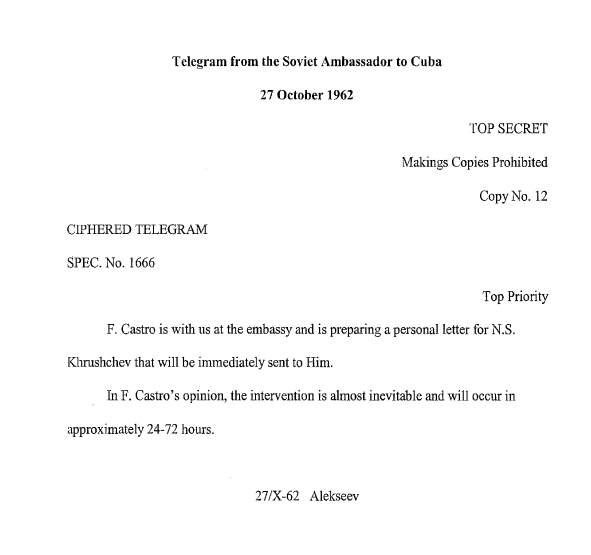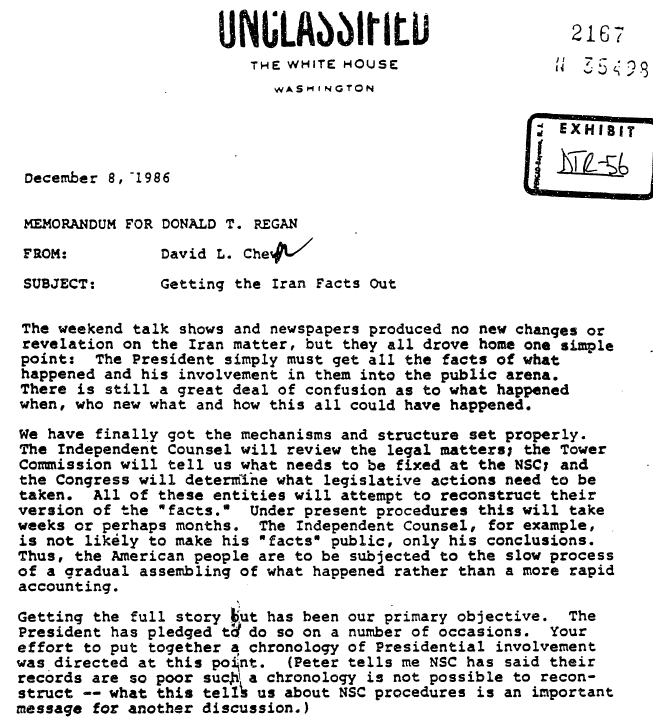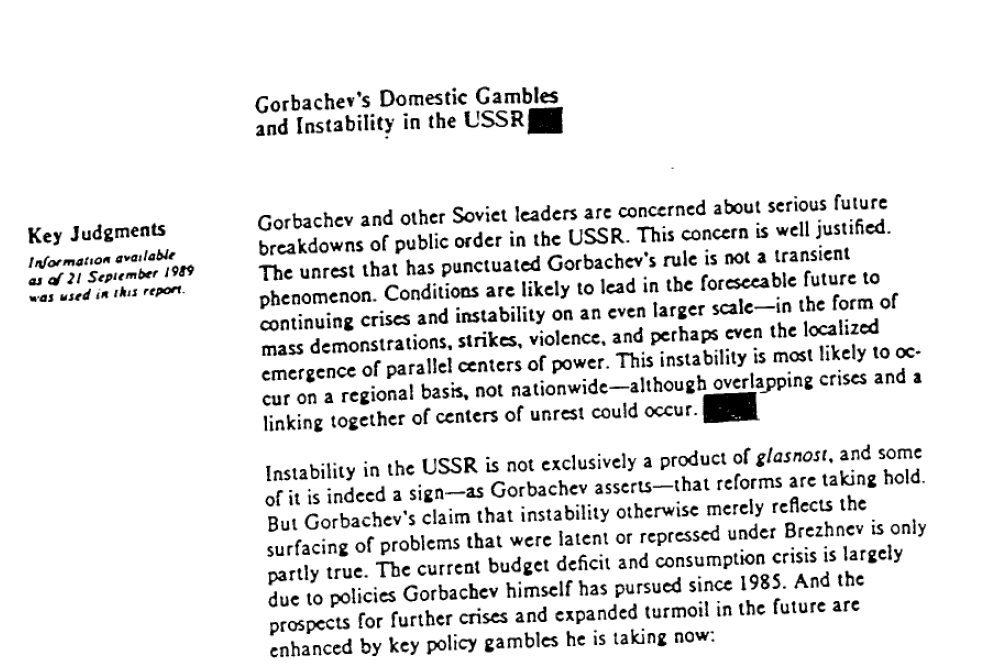New Resources – The Digital National Security Archive

The University of St Andrews Library now has access to eight archive collections from the Digital National Security Archive. The Digital National Security Archive is provided via Proquest and provides access to named collections of declassified documents, primarily from the United States, gathered and archived by the National Security Archive.
Based at George Washington University, the National Security Archive was formed in 1985 by Journalists and Scholars concerned about rising government secrecy. It is a leading not-for-profit user on the U.S. Freedom of Information Act, an advocate of open government, and is made up of an investigative journalism center, research institute on international affairs, a Library and Archive of declassified U.S. documents, and is a publisher and indexer of former secrets.
The eight collections are:
CIA Family Jewels Index
In 1973 the Central Intelligence Agency (CIA) Director, James R. Schlesinger, commissioned reports from all CIA Divisions in relation to CIA activities from the CIA’s foundation in 1947 to date, which could be considered out-with the agency’s official charter, therefore deemed illegal or inappropriate.
![7 May 1973 Memorandum for all CIA Employees. 1. Recent press reports implicate CIA in certain illegal [illegal is scored through and above is written improper] activities allegedly committed in the United States. Without going into the details of these allegations, I can assure you the I intend to cooperate fully with the various law enforcement and Congressional investigations into these matters.](https://library.wp.st-andrews.ac.uk/files/CIA-memorandum.png)
![Secret Eyes Only [Scored through] 16 May 1973. Memorandum for: Executive Secretary, CIA Management Committee. Subject: "Family Jewels"](https://library.wp.st-andrews.ac.uk/files/CIA-Family-Jewels.png)
The documents include details of CIA contacts with organised crime; involvement in assassination plots, detention, interrogation; surveillance of domestic journalists and anti-war movements in the US; investigations into other federal agencies; and support for White House political activities. Given the nature of these papers, the National Security Archive, based at George Washington University requested access to these documents under the Freedom of Information Act. 15 years after requesting access, the documents were released.
Whilst the documents available in the collections are declassified, many have been redacted
![Memorandum reads: "Count/DO-29. 23 May 1973. Foreign Support for Activities Planned to Disrupt or Harass the Republican National Convention. Summary: Indications remain limited on foreign plans or attempt to inspire, support, influence, or exploit actions designed to disrupt or harass the Republican National Convention in Miami, Florida 21-23 August 1972. [redacted paragraph] The British-based International Confederation for Disarmament and Peace (ICDP) has distributed a "Spring Offensive Calendar" of activities in the United States against the war based on the submission by the Peoples' Coalition for Peace and Justice (PCPJ). The calendar includes actions planned in connection with the Republican Convention. Developments: [redacted paragraph] The International Confederate for Disarmament and Peace, the British-based antiwar organisation and one of the "](https://library.wp.st-andrews.ac.uk/files/Redacted-report.png)
Providing detailed accounts of the operational and diplomatic history of U.S. covert operations, from the inauguration of President Jimmy Carter in 1977 to the George W. Bush administration, although a few Obama-era documents are also included. Containing 2,337 declassified documents from the CIA, the Department of State, the White House, the National Security Council, and a variety of others, the set provides a wide-ranging look into the intricacies of CIA covert action. It includes documents relating to operations such as the US Support of the Mujahadeen during Soviet occupation of Afghanistan; propaganda operations involving Radio Free Europe / Radio Liberty; US efforts to halt Cuban activities in Africa; programmes to arm the Contras in Nicaragua; actions against Libya during the Reagan administration; and CIA rendition and interrogation during the “War on Terror”.
The Cuban Missile Crisis: 50th Anniversary Update
Often considered one of the most dangerous and confrontational periods of the Cold War, this collection of primary sources includes documents from US and Soviet official archives; correspondence between Kennedy and Khrushchev; the archive of Mikoyan, the Soviet leader who worked closely with Cuba and helped negotiate the end of the Crisis; US Navy tracking reports; briefing documents from the Joint Chiefs of Staff planning an invasion of Cuba; and the CIA’s internal history of the failed 1961 Bay of Pigs invasion.

Iran: the Making of U.S. Policy, 1977-1980
Over 14000 pages of documentation focusing on U.S policy towards Iran and events in Iran during the period of January 20, 1977, to January 29, 1980, during the fall of the Shah and the rise of Ayatollah Khomeini.
Including primary sources from US government libraries and archives and federal agencies requested under the Freedom of Information Act, and the State Department “White Papers”, a major internal review by the Carter Administration into US-Iranian relations.
The Iran-Contra Affair: The Making of a Scandal, 1983-1988
The Iran-Contra document collection provides a contemporary record of the political, military and paramilitary operations, overt, covert and extra-official, which served as the foundation for the most significant American scandal since Watergate. The collection consists of 4,635 documents, approximately 14,000 pages. The bulk of the documentation was produced between the fall of 1983, when Congress first put significant limits on official U.S. assistance to the Nicaraguan Contras, and the end of 1986, when the Iran initiative and the Contra resupply operations were publicly exposed, and official investigations began. The collection include every exhibit released by the official investigations of the Iran-Contra Affair, including the Senate Intelligence Committee, the Tower Commission, the joint select Congressional committees, and the Independent Counsel.

Iraqgate: Saddam Hussein, U.S. Policy and the Prelude to the Persian Gulf War, 1980-1994.
This collection focuses on two major issues central to the Iraqgate affair. The first is U.S. policy toward Iraq during the 1980s up to the invasion of Kuwait in August 1990. The second is the Banca Nazionale del Lavoro (BNL) affair, which came to the attention of the authorities and the public during the summer of 1989, following the revelation that the small Atlanta branch office of BNL had provided Iraq with several billion dollars in off-book loans and credits. The documents can be roughly divided into three major categories. The largest consists of materials created by U.S. government agencies. The collection also contains several hundred documents from the UK concerned with British export policy toward Iran and Iraq during and after the Iran-Iraq war. The third major category consists of documents specifically describing BNL-Atlanta and its transactions with Iraq. A large number of documents relating to Iraqgate remain classified, so the collection is incomplete.
South Africa: the Making of U.S. Policy, 1962-1989
The South African document collection provides a contemporary record of changing U.S. responses to historical events in South Africa from 1962 to 1989. Coveted for its resources, supported as an ally, empowered by its nuclear capability and hated for its policy of apartheid, South Africa was considered a country of extremes. Reactive in nature, U.S. policies toward South Africa reflect a desire to reconcile conflicting interests in South Africa and the region. The collection focuses the themes of US Policy in relation to Arms Embargoes; Nuclear collaboration; Economics Sanctions; and Regional Conflict.
![[Scored out] Confidential . The Rivonia Accused. Nelson Mandela, former lawyer, leader in the Congress Youth League, Deputy National President under Chief Lithuli; an organizer of the passive resistance campaign of 1952; one of 156 defendants in the Treason Trial of 1956, all of whom were acquitted in 1961; main leader of the demonstrations against inauguration of the Republic in 1961 and of "Spear" in the underground. He is one of the most popular African nationalists in South Africa. Walter Sisulu, general secretary of the African National Congress since 1949. In 1953 he visited the USSR and China. Left-wing and possibly a Communist. Co-defendent in Treason Trial. Widely respected in Afro-Asian circles. Dennis Goldberg, European, leader on Communist-front Congress of Democrats. Goven Mbeki, national chairman of the African National Congress, one of the ablest African nationalists, listed by the South African Govenrment as a Communist. A.M. Kathrada, Indian, an organizer of the 1952 passive resistance campaign, official in the Indian Congress, Peace Council and other leftist organizations. Admitted Communist. Under house arrest since 1962. Lionel Bernstein, White architect, Communist since 1939. Co-defendant in Treason trial. Raymond Mhlara, Communist since early 1940's, jpoined African National Congress in 1944. Elias Motsoaledi, was a member of Communist Party, joined African National Congress in 1948 and became member of provincial executive, active in labor unions, detained in solitary confinement for 50 days in 1963 under 90-day detention provision. Andrew Mlangeni, joined African National Congress Youth League in 1951 and became branch secretary of the African National Congress in 1956. [Scored through] Confidential.](https://library.wp.st-andrews.ac.uk/files/The-Rivonia-Accused.png)
Covering the duration of the Cold War, these documents represent the product of U.S. intelligence analysis of Soviet foreign policy, military capabilities, the economy, Soviet science and technology, and the internal situation – including both leadership politics and the situation within the country as a whole. The set includes a number of additional documents produced by the CIA and other U.S. intelligence agencies that address similar topics.

As more documents are declassified they will be added to the collections to provide a more complete picture of the policies and actions of the U.S. in relation to it’s Foreign Policy and International Relations from the end of the Second World War to the present.